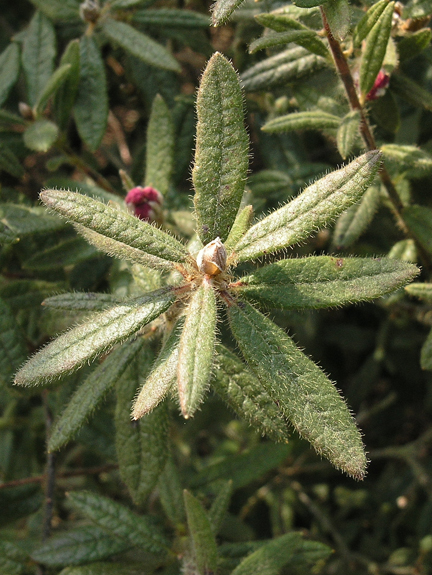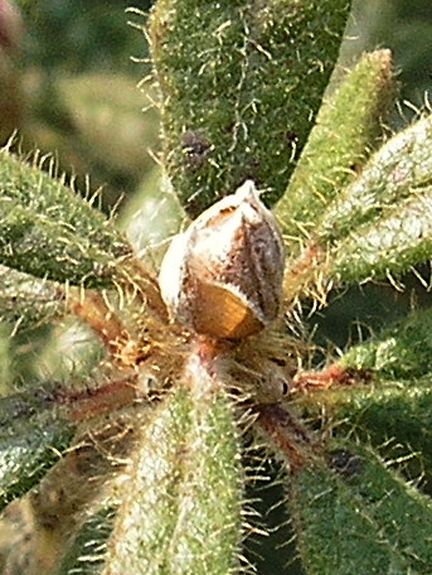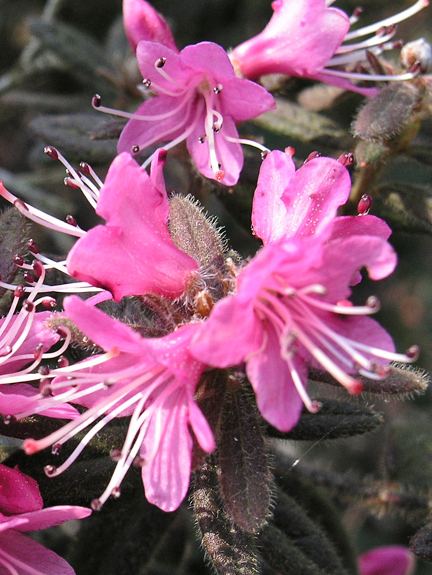
Woody > Rhododendron > Rhododendron spiciferum > Rhododendron spiciferum
Rhododendron spiciferum
Spicifer Rhododendron
Origin: Native to Guizhou and central and south-east Yunnan provinces in China.
Mike's
Opinion


"
A species that is rarely used in landscapes or seen in modern gardens to date beacause it is somewhat problematic in its culture. R. spiciferum can reach heights of 2 meters (extreme), depending on the experience and knowledge of the grower. An appealing evergreen shrub with interesting foliage but uncommonly incorporated in landscape.
Michael Pascoe, NDP., ODH., CLT., MSc. (Plant Conservation)
"
| Family |
| Ericaceae |
| Genus |
| Rhododendron |
| Species |
| spiciferum |
| Category |
| Woody |
| Type |
| Shrub (evergreen) |
| Pronunciation |
| USDA Hardiness Zone |
| 10a-5b |
| Canadian Hardiness Zone |
| 8a-4b |
| Temperature (°C) |
| 40 to -18 |
| Temperature (°F) |
| 90- to -5 |
| Height |
| 0.6-2 m |
| Spread |
| 1.5 m |
Photographs
Description and Growing Information
Flowering Period
| General Description |
| Slow growing species from China, unusually tomatose and open growing. |
| Landscape |
| Botanical and privately owned gardens where soil pH. levels can be closely monitored. R. Spiciferum is non-salt tolerant and precise growing conditions rely on acidic soil environments: not commonly used In urban landscapes. |
| Cultivation |
| Many of the problems in gardens can be minimized by maintaining soil quality and good air circulation. All rhododendron species prefer soil pH of 4-6 with open soil drainage and a cool root environment. |
| Shape |
| Informal, open shrub. |
| Growth |
| Slow |
| ID Characteristic |
| Small multi-branched shrubs, 0.2–0.6(–2) m tall. The older branches may be less hairy than the younger ones. New shoots are thin, densely gray-white-pubescent and spreading-hispid. The flower are funnelform, five lobed, borne in a raceme of 1-4 blooms, being pink or rarely white. |
| Pests |
| Powdery mildew. |
| Habitat |
| Native to Guizhou and central and south-east Yunnan provinces in China. Found growing in coniferous forest, margins and thickets on slopes at 800-1900 m. |
| Bark/Stem Description |
| Newer growth is red/brown and tomentose while older growth is more textured and grey in colour. |
| Flower/Leaf Bud Description |
| White/brown bud with stubby tapered scales and is oval in shape. |
| Leaf Description |
| The leaf petiole is 1–3 mm in length and pubescent. The leaf itself is quite tough with an almost papery texture to it. It is narrowly oblong to oblong-lanceolate and is can be up to 4 cm long and 1.5 cm wide. The leaf base is cuneate or obtuse with a revolute leaf margin. The leaf apex rounded or acute, and apiculate. The abaxial surface is yellowish green, to densely yellow and scaly with densely gray-white-pubescent hairs longer along the veins. The adaxial leaf surface is deep green and densely pubescent. The midrib is raised abaxially and concave adaxially while the lateral veins are slightly concave or flat above and slightly raised below. |
| Flower Description |
| The inflorescence is subterminal, shortly racemose with 1-4 blooms. There are several flower bud scales which are densely gray-white-villous and quite scaly. The flower pedicel is 4-7 mm in length and may be sparsely or densely scaly, pubescent. The flower has 5 calyx lobes which are ovate to oblong-ovate and are 0.5–2 mm in size. The flower corolla is funnelform, 5-lobed to below middle, pink or rarely white and 1.3–1.6 cm in length: the tube is longer than lobes. The outer surface of the flower is glandular-scaly in texture and appearance. There are 10 stamens to a bloom which are of unequal length with the longest nearly as long as the corolla. The filaments are pubescent below. The ovary 5-locular, densely gray-white-pubescent and scaly while the style is slender, exserted from corolla and pubescent below or glabrous. |
| Fruit Description |
| C grey-brown coloured cylindrical capsule from 6–10 mm in length that is , scaly and pubescent. |
| Colour Description |
| Light green foliage adaxially while abaxially it might tend towards yellow/brown: pink purple to rarely white flowers. |
| Texture Description |
| Leather like leaves with coarse hairs giving the foliage a tough papery texture. the overall plant texture is medium-coarse. |
| Notable Specimens |
| Kunming Botanical Gardens, China. |


